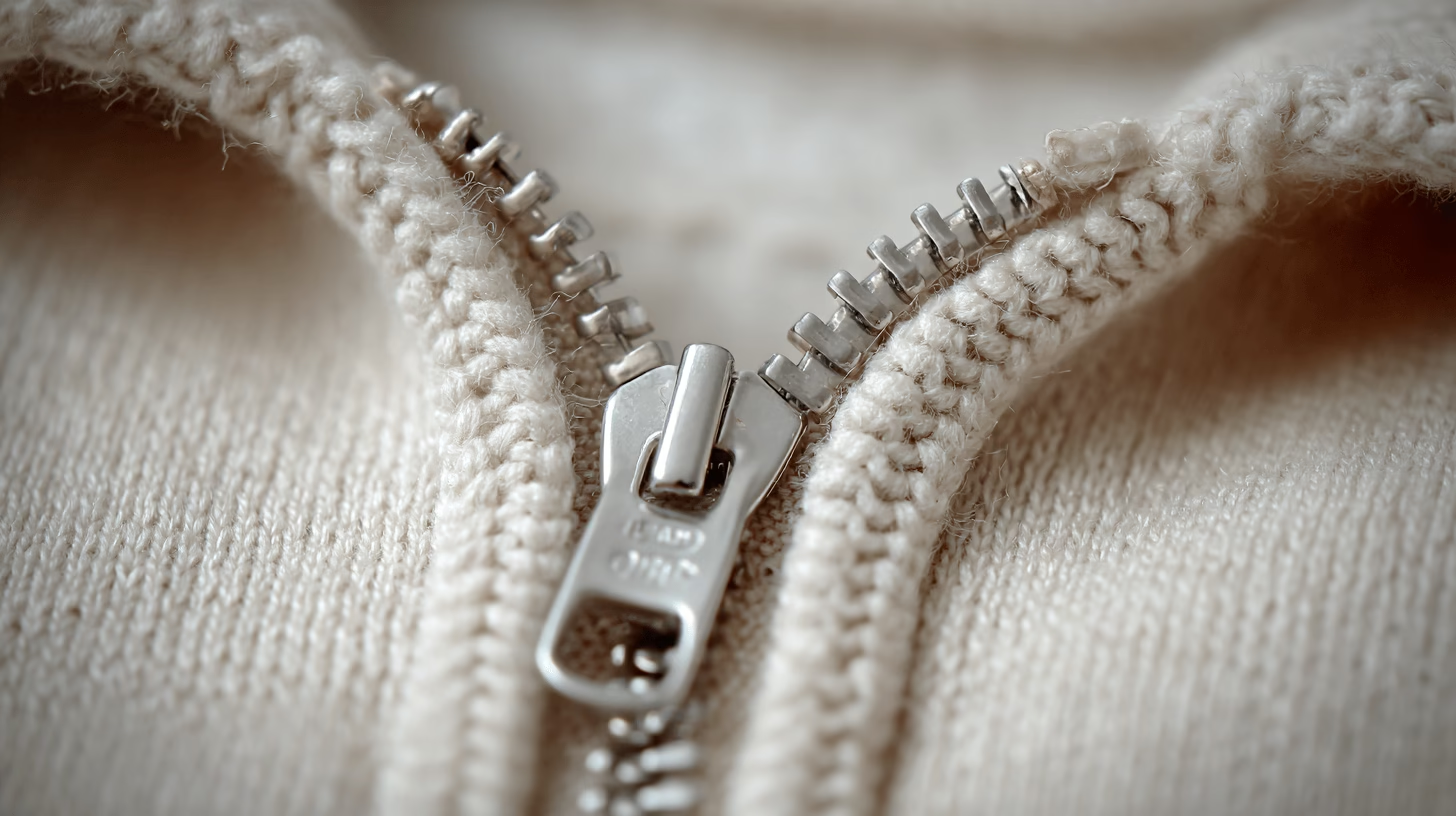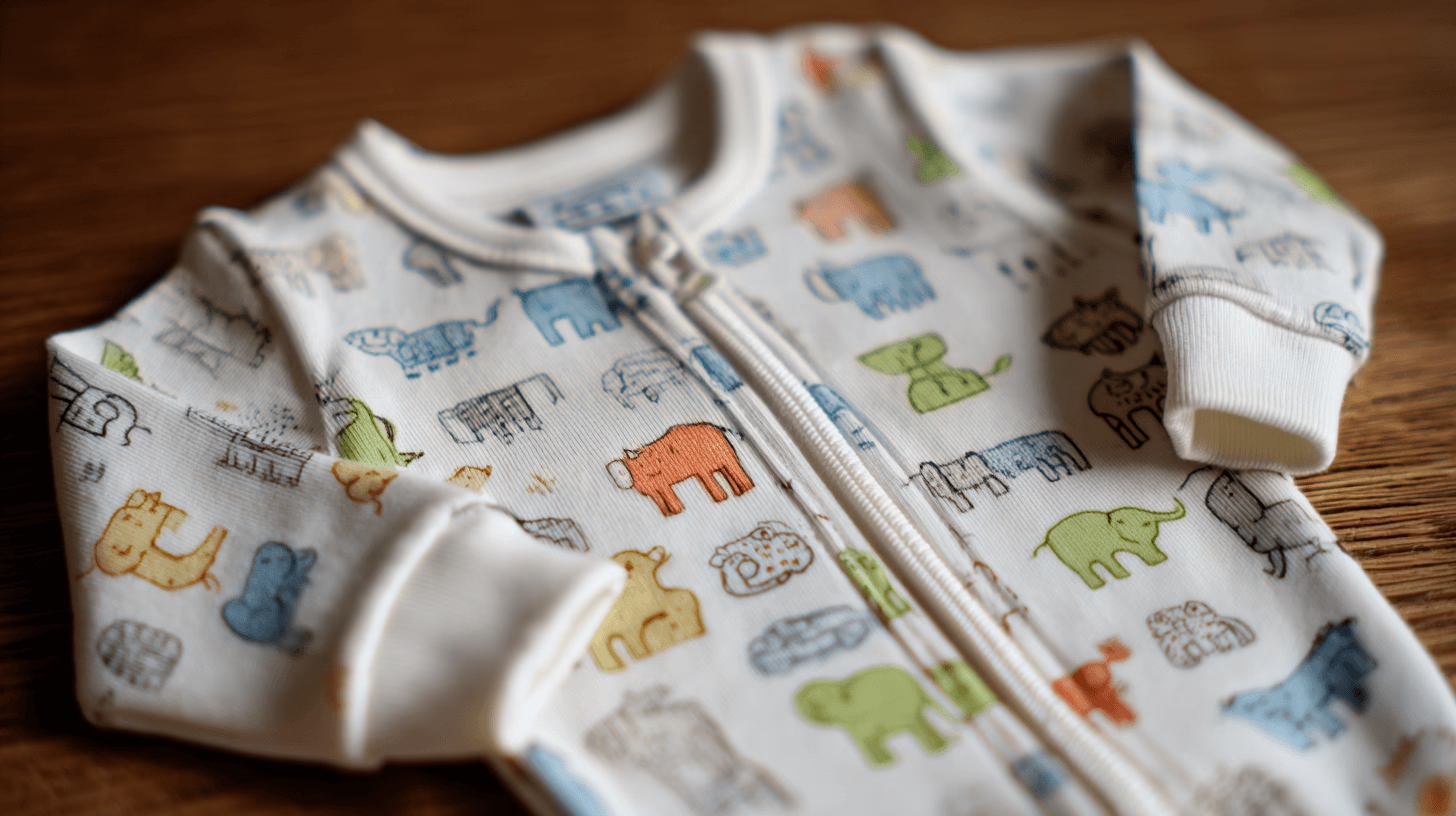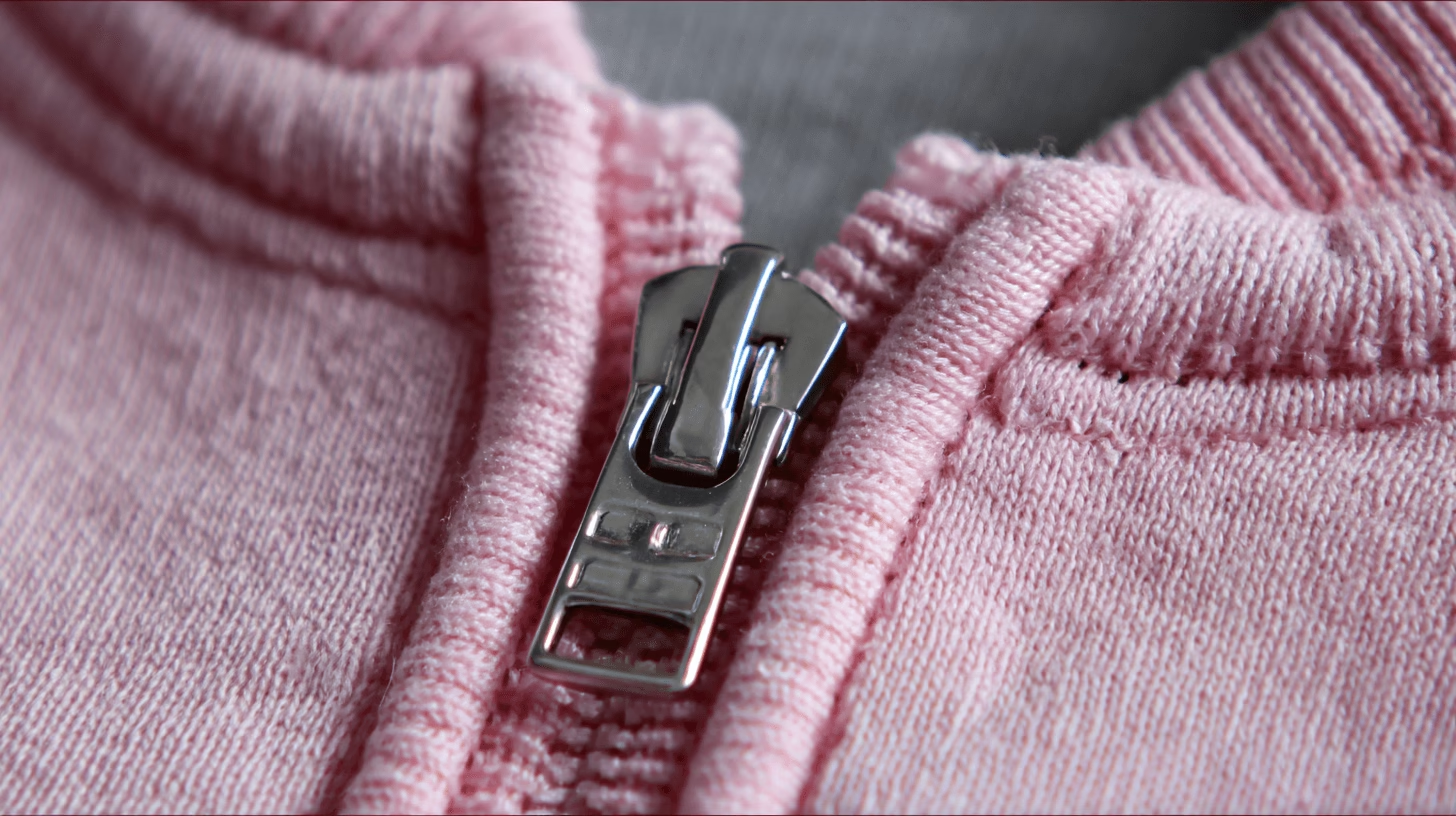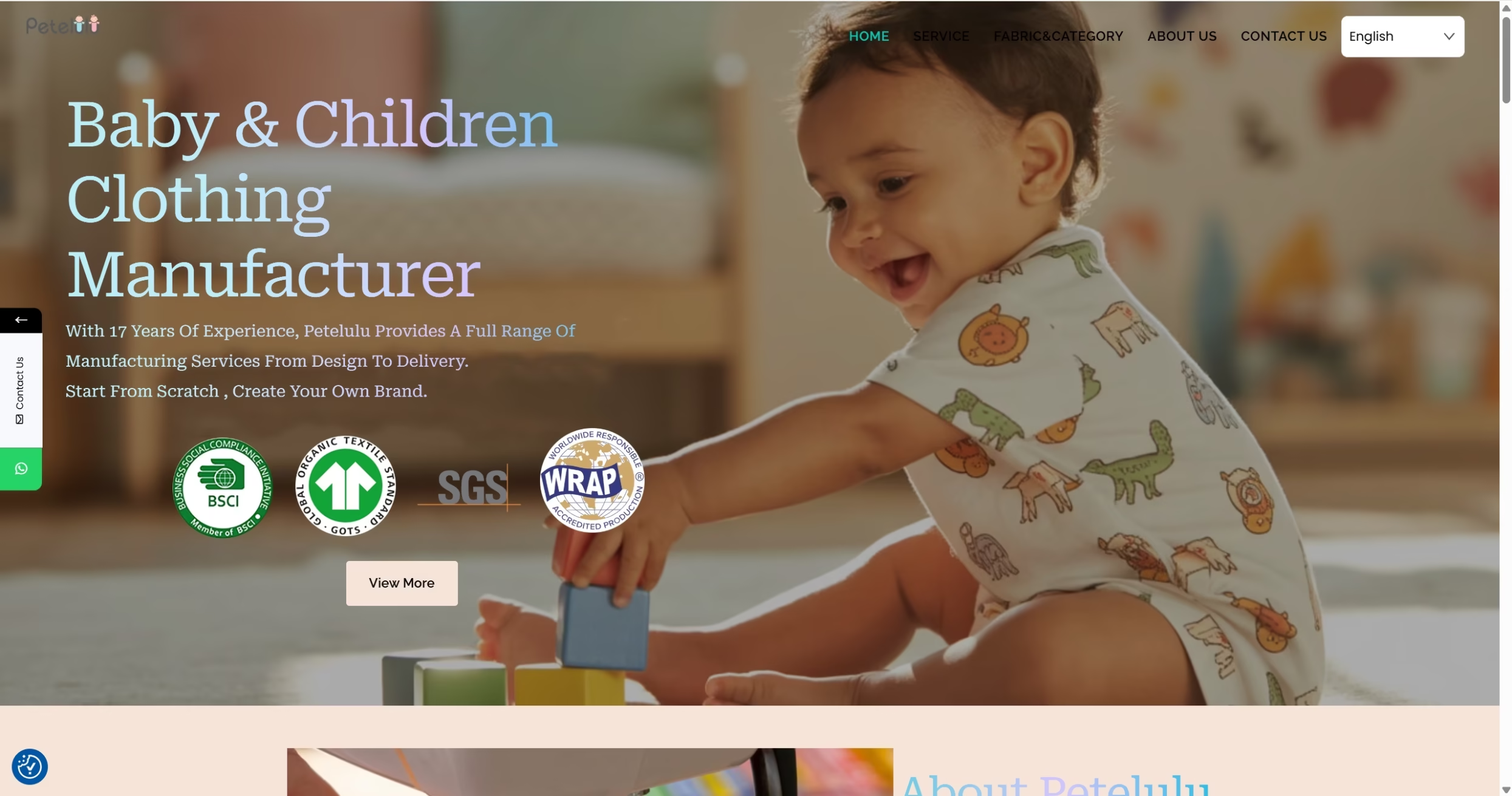Choosing the Right Zippers for Baby Clothes: A Manufacturer’s Guide
Choosing the Right Zippers for Baby Clothes: A Manufacturer’s Guide
Contents
- 1 Choosing the Right Zippers for Baby Clothes: A Manufacturer’s Guide
- 1.1 Introduction
- 1.2 Understanding Zipper Types for Baby Clothing
- 1.3 Selecting the Right Zipper Specifications
- 1.4 Safety Considerations for Baby Clothes Zippers
- 1.5 Practical Zipper Applications in Baby Apparel
- 1.6 Manufacturing and Sourcing Best Practices
- 1.7 Conclusion
- 1.8 Petelulu is Your Best Partner for Starting Your Kids’ Clothing Line

Introduction
When it comes to baby apparel manufacturing, the smallest details make the biggest difference. Since their invention in 1913, zippers have revolutionized clothing functionality—yet selecting the wrong type for infant wear can lead to safety hazards, frustrated parents, and ultimately, damaged brand reputation. As manufacturers know all too well, a zipper that pinches delicate skin or fails after a few washes quickly turns a quality garment into a returned product.
For baby clothing producers, the zipper dilemma is real: metal options may be durable but pose safety concerns; plastic varieties offer color versatility but varying quality levels; and decisions about separating versus non-separating styles directly impact a garment’s usability. Add to this the critical considerations of proper sizing, appropriate gauge selection, and the balance between aesthetic appeal and practical function—and it’s clear why thoughtful zipper selection is essential to successful baby apparel design. 💭✂️
In this comprehensive guide, we’ll walk through everything manufacturers need to know about choosing zippers for infant clothing—from understanding the fundamental differences between zipper types and specifications to implementing crucial safety features that parents demand. We’ll explore practical applications across various baby garment styles and share best practices for manufacturing and sourcing that maintain both quality and competitive pricing.
View more: The Ultimate Guide to Sourcing Eco-Friendly Fabrics for Baby Wear

Understanding Zipper Types for Baby Clothing
View More:Top 10 Children’s Clothing Manufacturers to Watch in 2025
Metal vs. Plastic vs. Nylon (Coil) vs. Invisible Zippers
When manufacturing baby clothes, selecting the appropriate zipper type is crucial for both functionality and safety. Metal zippers, while durable, may pose safety concerns as they can have sharp edges that may cause lacerations. Additionally, metal components could present choking hazards if they become detached. Plastic zippers offer a safer alternative as they typically have smoother edges and are lighter weight, reducing potential injuries from improper fit. Nylon or coil zippers provide flexibility and are generally comfortable against a baby’s sensitive skin, making them ideal for everyday baby garments. Invisible zippers, though aesthetically pleasing, should be carefully evaluated for safety considerations before implementation in baby clothing.
Separating vs. Non-Separating Zippers and Their Applications
The functionality of zippers significantly impacts the usability of baby garments. Separating zippers, which completely divide when unzipped, are excellent for items like footed pajamas or jackets that require easy dressing. These can simplify the process of dressing newborns and reduce stress for both parent and baby. Non-separating zippers, which remain attached at one end, are more suitable for partial openings such as those found on the back of dresses or partial front plackets. When considering rapid growth in newborns, garments with separating zippers may provide better accessibility and longevity of use.
YKK Zippers: Industry Standard for Quality and Safety
YKK zippers have established themselves as the industry benchmark for quality and safety in baby apparel manufacturing. Their rigorous testing processes ensure that zippers meet stringent sourcing and safety criteria to prevent risks. This is particularly important as poorly designed clothing components can lead to serious hazards for infants. YKK zippers are manufactured to minimize choking risks from small parts and to prevent potential injuries from zipper failure. For baby clothes in sizes 0-5T (USA) and 0-6X (Canada), which must adhere to strict safety standards, YKK zippers offer reliable compliance with these regulations.
When selecting zippers for baby clothes, manufacturers should prioritize those that facilitate easy dressing while maintaining the highest safety standards. While some references suggest that snaps may be more practical than zippers for newborn clothing due to easier access during diaper changes, zippers that are thoughtfully incorporated can still provide convenience and safety when properly selected and installed.
With a clear understanding of the various zipper types available for baby clothing, let’s now explore the specific considerations for selecting the right zipper specifications to ensure both functionality and safety in your baby apparel products.
View More:How Bulk Ordering Summer Kids’ Clothing Can Save Your Business Money in 2025

Selecting the Right Zipper Specifications
Now that we have covered the various zipper types suitable for baby clothing, it’s crucial to focus on the specific requirements that make a zipper both functional and appropriate for infant wear. The right specifications ensure not only ease of use but also contribute significantly to the safety and comfort of the baby.
A. Zipper Gauge Selection: Finding the Appropriate Size (#3, #5)
When manufacturing baby clothes, selecting the appropriate zipper gauge is essential. For most baby garments, smaller gauges like #3 are ideal as they provide a lightweight, flexible closure that won’t add unnecessary bulk or weight to delicate clothing items. The #3 gauge offers:
-
Lower profile that minimizes potential skin irritation
-
Flexibility that moves with the baby’s activities
-
Lighter weight suitable for newborn clothing
For slightly sturdier items like jackets or sleep sacks, a #5 gauge may be more appropriate as it offers:
-
Enhanced durability for frequently used garments
-
Better handling for parents operating zippers with one hand
-
Stronger teeth that withstand repeated washing
Similar to how prong snaps are chosen for their low profile in layered baby clothes, smaller gauge zippers provide comfort without compromising functionality.
B. Color Considerations: Standard Options vs. Dyed-to-Match (DTM)
Color selection plays both a practical and aesthetic role in zipper specification:
Standard Options:
-
Come in a range of basic colors (white, black, cream)
-
More economical for large production runs
-
Readily available with shorter lead times
Dyed-to-Match (DTM):
-
Creates a seamless look with the fabric
-
Enhances the premium feel of the garment
-
Particularly important for visible zippers on outerwear
Just as KAM snaps offer extensive color variety for customization, DTM zippers allow manufacturers to maintain brand consistency across all components of the garment.
C. Custom Zipper Pulls for Brand Identity and Enhanced Functionality
Custom zipper pulls serve dual purposes in baby clothing manufacturing:
Brand Identity:
-
Logo-embossed pulls create recognition
-
Unique shapes distinguish your products in the market
-
Consistent design elements across product lines
Enhanced Functionality:
-
Larger pulls make it easier for parents to operate
-
Ergonomic designs accommodate one-handed use during diaper changes
-
Soft-touch materials prevent scratching delicate skin
Custom pulls can be designed with considerations similar to those for choosing between snaps and zippers for newborns—focusing on accessibility and ease of use during frequent clothing changes.
With these specifications in mind, next, we’ll explore the critical safety considerations that must be addressed when incorporating zippers into baby clothing designs. While proper specification selection forms the foundation, ensuring these components meet rigorous safety standards becomes our paramount concern.
View More:How to Find Old Money Style Kidswear Manufacturers That Prioritize Sustainability in 2025

Safety Considerations for Baby Clothes Zippers
Now that we have covered the specifications needed for selecting the right zippers for baby clothing, it’s crucial to address the safety aspects that manufacturers must prioritize. Safety standards are non-negotiable when designing apparel for infants and toddlers, especially when it comes to components like zippers that can pose various risks.
Avoiding Irritants and Hazardous Components
When manufacturing baby clothes with zippers, it’s essential to avoid materials that contain toxic chemicals or irritants that could harm a baby’s sensitive skin. According to safety guidelines, zippers must meet stringent sourcing and safety criteria to prevent risks. Manufacturers should be particularly cautious about:
-
Metal components that might contain lead or other hazardous substances
-
Chemical treatments that could leach onto skin
-
Small zipper pulls that could detach and pose choking hazards for babies in the 0-5T (USA) and 0-6X (Canada) size ranges
-
Sharp edges on zipper teeth or pulls that may cause lacerations
Rigorous testing is necessary to ensure all zipper components comply with established safety standards before being incorporated into baby apparel.
Choosing Zippers That Won’t Pinch Delicate Skin
Babies have delicate skin that can easily be pinched or irritated by poorly designed zippers. Manufacturers should:
-
Select zippers with covered or protected teeth to prevent skin from getting caught
-
Use zipper guards or fabric overlays to create a barrier between the zipper and the baby’s skin
-
Ensure zipper pulls are smooth and rounded without sharp edges
-
Test zipper mechanisms thoroughly to prevent jamming that might lead to pinching
These considerations are particularly important as the reference material highlights that poorly designed clothing can lead to injuries from improper fit, which includes components like zippers.
Balancing Safety with Ease of Use for Parents
While prioritizing baby safety, manufacturers must also consider the practical needs of parents who will be frequently operating these zippers during diaper changes and dressing:
-
Design zippers that operate smoothly with one hand
-
Incorporate larger pulls that are easy to grip but cannot be detached by a baby
-
Position zippers in accessible locations that don’t compromise safety
-
Ensure closure mechanisms are secure enough to prevent a baby from opening but manageable for parents
The goal is to prevent hidden dangers while creating functional garments, as many potential hazards may remain unrecognized by consumers.
With these safety considerations in mind, next, we’ll explore practical zipper applications in baby apparel, demonstrating how these safety principles can be implemented in different types of baby clothing while maintaining comfort and style.

Practical Zipper Applications in Baby Apparel
Now that we have covered the safety considerations for baby clothes zippers, let’s explore how to effectively apply these fasteners in various baby garment designs. Understanding the practical applications of zippers can significantly enhance both the functionality and appeal of your baby clothing line.
Accessibility for Frequent Diaper Changes
Zippers offer exceptional convenience for parents during diaper changes, which occur frequently throughout the day and night. According to parental testimonials, zip-up bodysuits are particularly praised for their user-friendly design, allowing for easy dressing over a baby’s head. This accessibility becomes even more valuable during nighttime changes when parents are sleep-deprived.
One satisfied parent highlighted that “the ease of use provided by zippers during diaper changes” made their nighttime routines considerably more manageable. This practical benefit should be a key consideration when designing baby apparel, as functionality directly impacts customer satisfaction and loyalty.
For optimal diaper-changing accessibility, consider:
-
Full-length zippers that extend from neck to ankle
-
Two-way zippers that allow for changing without completely undressing the baby
-
Zipper paths that provide clear access to the diaper area
Comparing Zippers vs. Snaps for Different Garment Types
While zippers have significant advantages, it’s important to understand when they’re preferable to snaps and vice versa. Historical data reveals that zippers became prevalent in infant garments in the early 20th century due to their simplicity and efficiency, while snaps have an even longer history in children’s clothing.
Recent polls indicate that over 80% of parents prefer zippers for their ease of use, especially during late-night changes. However, snaps offer unique benefits in specific scenarios:
Zippers excel in scenarios requiring quick dressing and diaper changes, particularly during nighttime. Snaps, meanwhile, provide superior accessibility for medical situations, such as in NICU settings, and can better adapt as the baby grows.
Optimal Zipper Placement for Maximum Comfort
Proper zipper placement is critical for ensuring both functionality and comfort. When designing baby apparel, consider these placement guidelines:
-
Avoid Sensitive Areas: Position zippers away from the baby’s skin, particularly around the neck and under the chin where chafing might occur.
-
Facilitate Natural Movement: Place zippers in ways that don’t restrict movement, especially for active babies who are beginning to crawl or roll.
-
Consider Practical Access: For bodysuits, diagonal or asymmetrical zippers can provide better access for diaper changes while keeping the baby’s upper body covered and warm.
-
Temperature Regulation: Strategic zipper placement can help with temperature management. For instance, partial zippers on the front of sleepwear can be opened slightly to help cool an overheated baby without completely undressing them.
Many parents specifically mention the comfort aspect in testimonials, with one father noting “the luxury feel” of well-designed zipper garments made from soft cotton. Combining high-quality materials with thoughtful zipper placement creates garments that are both practical and comfortable.
With this understanding of practical zipper applications in baby apparel, manufacturers can now move on to exploring manufacturing and sourcing best practices to ensure the highest quality and safety standards in their production process.

Manufacturing and Sourcing Best Practices
Now that we’ve explored the practical applications of zippers in baby apparel, it’s essential to understand the manufacturing and sourcing best practices that ensure both quality and compliance. Selecting the right zipper is only part of the equation; implementing proper manufacturing processes and sourcing strategies is equally critical.
Quality Control Standards for Baby Clothing Zippers
Quality control for baby clothing zippers must align with stringent regulatory requirements, particularly the Consumer Product Safety Improvement Act (CPSIA). As a manufacturer, you need to implement:
-
Mandatory third-party laboratory testing of zipper components, with costs starting around $300 depending on product complexity
-
Issuance of Children’s Product Certificates (CPC) that document compliance with safety standards
-
Comprehensive CPSIA tracking labels containing production details, batch information, and manufacturing location
-
Adherence to ASTM standards specifically designed for children’s clothing components
When sourcing zippers, verify that suppliers can provide documentation of compliance with these standards, as non-compliance can result in product recalls, platform removal, or account suspensions on selling platforms like Amazon.
Cost Considerations Without Compromising Safety
While managing production costs is vital for competitive pricing, safety cannot be compromised. Consider these approaches:
-
Balance testing costs with production volume: Third-party testing starting at $300 can be cost-effective when amortized across larger production runs
-
Strategic sourcing: Partner with zipper suppliers who already comply with U.S. regulations for children’s products to reduce the burden of additional testing
-
Material selection: Choose zipper materials that meet both flammability standards under the Flammable Fabrics Act and toxic substance limitations under California’s Proposition 65
-
Documentation efficiency: Streamline the process of obtaining and maintaining regulatory documentation to reduce administrative costs
Remember that platforms like Amazon require approval documentation confirming compliance with all regulations, making proper documentation an investment rather than an expense.
Lead Times and Inventory Management for Zipper Components
Effective inventory management is critical for maintaining production schedules while meeting seasonal demands in the baby clothing market. Based on 2025 market insights:
-
Seasonal planning: Align inventory with emerging trends in children’s clothing, particularly for holiday seasons which require specialized zipper components
-
Supply chain transparency: Maintain detailed tracking of zipper components to fulfill CPSIA labeling requirements
-
Buffer stock strategy: Maintain appropriate safety stock of compliant zippers to accommodate fluctuating lead times, especially for specialized components like those used in sustainable baby clothing lines
-
Supplier relationship management: Develop partnerships with zipper suppliers who understand the regulatory landscape for baby clothing to ensure consistent quality and compliance
By implementing these best practices, manufacturers can navigate the complex regulatory environment while maintaining efficient production schedules and ensuring the safety of their baby clothing products.
Conclusion
Selecting the right zippers for baby clothing is a critical decision that directly impacts both functionality and safety. Throughout this guide, we’ve explored various zipper types, specifications, and safety considerations that manufacturers must prioritize when designing baby apparel. From choosing between metal, plastic, nylon, and invisible zippers to understanding gauge sizes and color options, each decision contributes to creating baby garments that are both practical for parents and comfortable for infants.
Remember that baby clothing requires special attention to detail—soft, stretchy fabrics paired with appropriate closures make dressing easier while preventing skin irritation. Whether you opt for custom zipper pulls to enhance your brand identity or select YKK zippers for their renowned quality, always prioritize safety by ensuring zippers are securely attached and properly covered to protect delicate skin. By implementing the manufacturing and sourcing best practices outlined in this guide, you’ll create baby garments that stand out in the marketplace while meeting the essential needs of your smallest customers and their parents.
Petelulu is Your Best Partner for Starting Your Kids’ Clothing Line
If you’re looking for a reliable clothing manufacturer for your children’s clothing line, Appareify will be your top choice. Here is why we can relieve stress for your kids’ clothing business:

Custom Children’s Clothing Manufacturer
Appareify is a leading clothing manufacturer that has assisted many businesses with their own range of bespoke clothing. We can create children’s clothing tailored for your style and material needs
Experienced Production & Team
Partner with Appareify and benefit from our years of clothing manufacturing expertise. Our professional design and production experts can easily turn your business ideas into reality.
Sustainable Commitment
We use biodegradable materials and fabrics to turn your ideas into reality sustainably. You’ll get children’s clothing that is friendly to the environment.